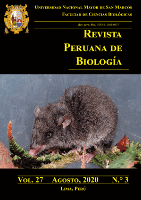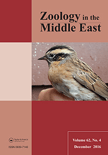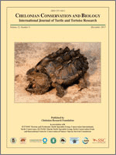
CONSERVATION GENETICS
Scope & Guideline
Unlocking Genetic Insights for Species Survival
Introduction
Aims and Scopes
- Population Genetics and Structure:
Research often focuses on understanding the genetic structure of populations, identifying distinct conservation units, and evaluating genetic diversity within and among species. This includes the use of genomic tools to analyze population dynamics and connectivity. - Conservation Genomics:
The journal emphasizes the application of genomic data in conservation efforts. Studies may explore how genetic information can inform management practices, assess genetic health, and guide restoration initiatives for endangered species. - Impact of Environmental Factors:
Many publications investigate how factors such as habitat loss, climate change, and human activities influence genetic diversity and population connectivity, providing crucial insights for effective conservation planning. - Translocation and Genetic Rescue:
Research often examines the genetic implications of translocation efforts aimed at restoring population viability and enhancing genetic diversity, including the assessment of genetic outcomes following such interventions. - Integration of Genetic Tools in Conservation Practice:
The journal highlights studies that integrate genetic methodologies with traditional conservation approaches, advocating for a multidisciplinary approach to biodiversity conservation.
Trending and Emerging
- Environmental DNA (eDNA) Applications:
There is a rising trend in the use of eDNA for monitoring and assessing species presence and diversity. This approach allows for non-invasive sampling and enhances the ability to detect rare or elusive species, making it a powerful tool for conservation. - Machine Learning and Genomic Data Integration:
The integration of machine learning techniques with genomic data is becoming more prominent, facilitating advanced analyses of genetic diversity and population structure. This trend reflects a broader move towards data-driven approaches in conservation genetics. - Focus on Climate Change Resilience:
Emerging studies are increasingly addressing how genetic diversity contributes to species resilience in the face of climate change. This theme highlights the role of genetic variation in adapting to changing environments and informs conservation strategies aimed at enhancing species survival. - Conservation of Marine Species and Ecosystems:
Publications focusing on marine species and their genetic health are on the rise, reflecting a growing awareness of the need to protect marine biodiversity amid threats such as overfishing and habitat degradation. - Community Genetics in Conservation:
There is an emerging interest in understanding the genetic interactions within communities, including how species coexist and the implications for ecosystem stability and conservation strategies.
Declining or Waning
- Traditional Morphological Studies:
There has been a noticeable decrease in publications focusing solely on morphological assessments of species, as genetic methods increasingly dominate the field. This shift reflects a broader trend towards molecular techniques that provide deeper insights into genetic diversity and population structure. - General Biodiversity Assessments without Genetic Context:
Research that merely catalogs species without integrating genetic data is becoming less common. The journal increasingly favors studies that contextualize biodiversity within genetic frameworks, emphasizing the importance of genetic diversity in conservation. - Studies on Species Without Immediate Conservation Relevance:
Papers focusing on species that are not currently threatened or endangered are less frequent in recent publications. The journal's emphasis is shifting towards research that has direct implications for conservation and management of at-risk species.
Similar Journals

Zoologia
Fostering Collaboration for Wildlife ConservationZoologia, published by the SOC BRASILEIRA ZOOLOGIA and UNIV FEDERAL PARANA, is a premier open-access journal dedicated to the field of zoology and related disciplines. Established in 2009 and based in Brazil, this journal has quickly positioned itself as a vital resource for researchers, professionals, and students, providing a platform for innovative research and comprehensive reviews in animal science and zoology. With an H-index indicative of its growing citation impact and a current Scopus ranking placing it in the 46th percentile of its category, Zoologia focuses on increasing the visibility and accessibility of cutting-edge zoological research. The journal aims to advance the understanding of animal biology, ecology, and conservation, making it an essential read for those invested in animal science. As an open-access publication, it ensures that knowledge dissemination is unrestricted, fostering a collaborative scientific community striving towards impactful conservation and biodiversity initiatives.

REVISTA PERUANA DE BIOLOGIA
Exploring Diversity in Biological Research Since 1974REVISTA PERUANA DE BIOLOGIA, an esteemed journal published by the Universidad Nacional Mayor de San Marcos, Faculty of Biological Sciences, has been a vital platform for disseminating significant biological research since its inception in 1974. With an Open Access model, this journal ensures that high-quality research is freely available to readers across the globe, fostering the advancement of knowledge within the field of agricultural and biological sciences. Despite proprietary challenges, the journal has secured a respectable Q3 category ranking in Agricultural and Biological Sciences and currently holds a 137th rank in Scopus among its peers. By embracing a comprehensive scope, REVISTA PERUANA DE BIOLOGIA encourages submissions that contribute to diverse biological topics, making it an essential resource for researchers, professionals, and students looking to enhance their understanding and expertise. With its ongoing commitment to excellence, this journal remains a cornerstone of biological research in Peru and beyond, reinforcing the importance of collaboration and knowledge sharing in the scientific community.

ZOOLOGY IN THE MIDDLE EAST
Highlighting the Unique Animal Heritage of the RegionZoology in the Middle East, published by Taylor & Francis Ltd, is a pivotal journal dedicated to advancing the field of zoological research with a distinct focus on the rich and diverse fauna of the Middle Eastern region. With its ISSN of 0939-7140 and an E-ISSN of 2326-2680, this journal has successfully carved out a niche for itself since its inception in 1986, covering topics of significant relevance to animal science and zoology, as evidenced by its Q2 ranking in the 2023 category quartiles. Although it operates as a subscription-based journal, it aims to disseminate high-quality research articles, reviews, and case studies that contribute to the understanding of animal biodiversity and conservation in the Middle East. With a Scopus ranking placing it in the 38th percentile of the agricultural and biological sciences category, Zoology in the Middle East serves as an essential resource for researchers, professionals, and students who seek to deepen their knowledge and appreciation of the region's zoological heritage. Scholarly contributions to this journal not only enhance scientific discourse but also inform conservation strategies and policy-making in an area that is critical to global biodiversity.

ZHURNAL OBSHCHEI BIOLOGII
Connecting Scholars Through Biological InsightsZHURNAL OBSHCHEI BIOLOGII, published by MEZHDUNARODNAYA KNIGA in the Russian Federation, is a venerable journal with a rich history originating in 1945. Renowned for its contributions to the fields of Ecology, Evolution, Behavior, and Systematics, as well as Medicine (miscellaneous), this journal provides a platform for researchers and professionals to disseminate significant findings within these domains. Although currently not classified as an open access publication, ZHURNAL OBSHCHEI BIOLOGII holds a Q4 quartile designation in its respective categories, reflecting its unique positioning within the global research landscape. While its coverage in Scopus is limited, the journal remains an important resource for academics interested in the evolution of biological sciences, especially within the context of Russian research traditions. By fostering scholarly communication and collaboration, ZHURNAL OBSHCHEI BIOLOGII continues to play a critical role in advancing knowledge in the biological sciences.

Molecular Ecology Resources
Unraveling Nature's Secrets Through Molecular InsightsMolecular Ecology Resources, published by WILEY, is a leading international journal that specializes in the intersection of molecular biology with ecology and evolution. With an impressive impact factor signified by its Q1 status in multiple categories, including Biotechnology, Ecology, Evolution, Behavior and Systematics, and Genetics for 2023, this journal stands as a reputable source of groundbreaking research within the fields of agricultural and biological sciences. Its Scopus rankings are particularly noteworthy, placing it in the top tier of its respective categories, demonstrating its significance in advancing our understanding of molecular ecology. The journal has been committed to fostering high-quality scientific discourse from 2008 to 2024 and offers open access options to enhance its visibility and accessibility. As a researcher, professional, or student in these dynamic fields, engaging with Molecular Ecology Resources means contributing to and staying informed about the latest innovations and methodologies that shape our understanding of the biological world.

PAKISTAN JOURNAL OF ZOOLOGY
Innovating animal biology insights from Pakistan and beyond.Pakistan Journal of Zoology, established in 1975 and published by the Zoological Society of Pakistan, is a pivotal resource in the field of zoology and animal science, contributing to the academic discourse and research advancements in the region. With an ISSN of 0030-9923, this journal strives to disseminate innovative research findings and scholarly articles that explore various facets of animal biology, ecology, and conservation. Although classified in the Q4 quartile within the animal science category, its commitment to providing a platform for emerging researchers makes it crucial for those in the zoological community. The journal covers a broad range of topics relevant to contemporary issues in zoology, promoting both local and international collaborations. Situated in Lahore, Pakistan, its contributions are vital for promoting biodiversity awareness and conservation efforts within the region. Accessible research outputs empower students and professionals alike to engage in critical discussions and applications within the disciplines of zoology and animal science.

Conservation Genetics Resources
Unlocking the Secrets of Conservation GeneticsConservation Genetics Resources, published by SPRINGER in Germany, is a key resource in the field of conservation science, focusing on the genetic aspects essential for biodiversity preservation and ecosystem management. With an ISSN of 1877-7252 and an E-ISSN of 1877-7260, this journal has established its presence as a vital platform for disseminating high-quality research that addresses the challenges of genetic conservation strategies. Notably, it has demonstrated a strong academic impact, currently holding a Q3 ranking in Ecology, Evolution, Behavior and Systematics and Q4 in Genetics for 2023, alongside Scopus ranks that position it as a notable contributor in its fields. This journal invites contributions that enhance the understanding of genetic diversity, population genetics, and conservation genomics, and it serves as an essential reference for researchers, professionals, and students committed to the preservation of our natural heritage. The access options are varied, catering to the needs of its diverse readership, and making it an indispensable addition to academic research spaces.

GENETICA
Pioneering Insights in Animal, Plant, and Insect GeneticsGENETICA is a prominent journal published by SPRINGER, dedicated to advancing the field of genetics and its applications across various biological disciplines, including animal science, plant science, and insect science. Since its inception in 1919, the journal has consistently served as a vital platform for researchers and professionals to disseminate high-quality research findings that explore the genetic bases of biological phenomena. With its current scope spanning from 1943 to 2024, GENETICA holds a commendable position in the academic community, as evidenced by its Q2 ranking in both animal science and insect science, and its active contribution to interdisciplinary studies in genetics. Although the journal does not offer open access, it remains accessible through institutional subscriptions and libraries, ensuring its vital research is widely circulated. Researchers, professionals, and students alike will find GENETICA an invaluable resource for the latest discoveries and methodologies in the ever-evolving landscape of genetics.

RUSSIAN JOURNAL OF GENETICS
Delving into the Depths of Genetic ScienceRUSSIAN JOURNAL OF GENETICS is a significant platform in the field of genetics, published by PLEIADES PUBLISHING INC since its inception in 1996. With an ISSN of 1022-7954 and an E-ISSN of 1608-3369, the journal focuses on a wide array of topics within genetics, providing researchers, professionals, and students with insights into advancements and discoveries in this ever-evolving discipline. While it currently holds a Q4 ranking in the 2023 Genetics category according to Scopus, representing invaluable opportunities for knowledge dissemination, the journal is actively working to enhance its impact in future rankings. Readers will find the journal a repository of diverse genetic research findings, methodologies, and theoretical advancements. Although it is not an open-access journal, it is committed to serving the academic community through rigorous peer-reviewed articles. With a consistent publication trajectory spanning to 2024, the RUSSIAN JOURNAL OF GENETICS remains a crucial resource for those aspiring to stay at the forefront of genetic research and applications.

CHELONIAN CONSERVATION AND BIOLOGY
Exploring the intricate world of turtles and tortoises.Chelonian Conservation and Biology is a distinguished academic journal dedicated to advancing the field of chelonian research, encompassing conservation, ecology, and biology of turtles and tortoises. Published by Allen Press Inc in the United States, this journal is well-regarded within the realm of Animal Science and Zoology, as well as Ecology, Evolution, Behavior and Systematics, holding a commendable Q3 ranking in both categories for 2023. With an ISSN of 1071-8443 and an E-ISSN of 1943-3956, the journal features a diverse range of articles aimed at professionals, researchers, and students, fostering an understanding of the critical challenges facing chelonians worldwide. Although not an open-access publication, Chelonian Conservation and Biology provides high-quality content, including original research, reviews, and case studies, encouraging engagement and collaboration among experts. With coverage extending from 2006 to 2024, the journal serves as a vital platform for disseminating knowledge and promoting conservation efforts essential to the survival of these remarkable species.